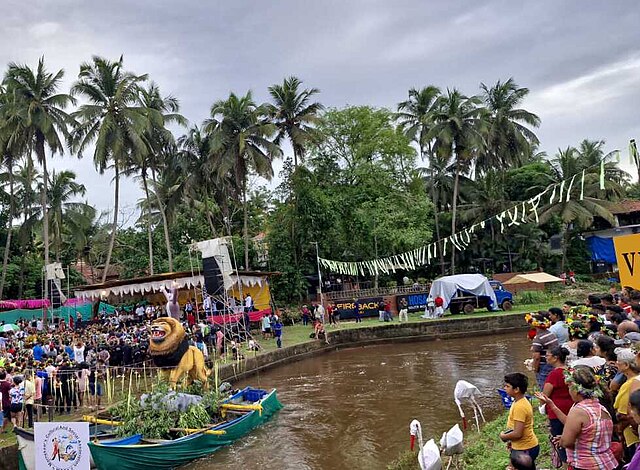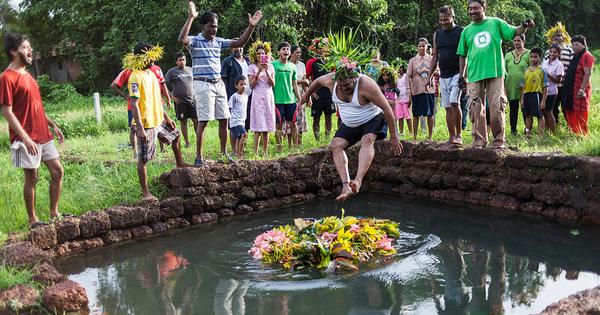
June 24 in Goa bursts with energy, color, and deep-rooted tradition as Goans celebrate São João, the feast of St. John the Baptist. More than just a religious observance, São João is a lively festival that brings together communities in a unique blend of faith, folklore, and festivity.
Celebrated primarily by Goa’s Catholic community, São João marks the birth of St. John the Baptist—Jesus Christ’s forerunner. Held at the onset of the monsoons, the festival comes alive especially in North Goa with unmatched zeal. One of its most iconic traditions is people leaping into wells, ponds, tanks, or even swimming pools. This joyful act draws inspiration from the biblical story of the unborn John leaping in his mother Elizabeth’s womb when Mary visited her.
The symbolic leap into water represents more than joy—it signifies baptism, cleansing, new life, and the awakening of nature brought on by the rains.
Honoring Sons-in-Law and Family Ties
In many Goan households, São João revolves around the son-in-law. Newlyweds often receive a warm invitation to the bride’s home, where the groom wears a vibrant kopel (crown), once made of guava fruits and now often woven with sanjuachi val. He then leaps into a well amidst merry songs and laughter. The in-laws gift the couple an ojem, a seasonal fruit basket including pineapples, mangoes, jackfruits, and bananas—an offering meant for the groom’s parents-in-law.
In another touching tradition, villagers parade the newly married son-in-law through the village. This custom arose after a tragic incident in which an unintroduced groom died in an accident while returning home. To honor and protect sons-in-law, communities began formally introducing them during São João.
Community Festivities and Folk Fun
The celebrations begin with morning Mass in honor of St. John the Baptist. After prayers, families return home to enjoy tea and snacks. While the men gather to tie and decorate boats, the women prepare the feast lunch, often featuring festive dishes like sorpotel, pork vindaloo, and sannas. At 12 noon, the men hoist the traditional maddi (flag), pray together, and jump into the well.
The real fun unfolds with the playful boat ceremonies. Men dress as women, perform humorous skits and dances on boats, and entertain crowds watching from the shore. The day ends with evening get-togethers, laughter, and shared meals.
In some villages, such as Siolim, locals organize the São João Traditional Boat Festival, where creatively decorated boats compete for prizes. Various wards participate, and the event features performances by local artists, kopel-making competitions, dress contests, and lively Konkani singing.
Villagers in Saligao celebrate through the Vangodd de Saligao, a community-led event involving all 19 somudai (Small Christian Communities). It begins with prayers at the church, followed by a vibrant lineup of folk dances, music, and traditional Goan cuisine featuring xit, sambarache kodi, von, pez, doce, and seasonal fruits.
In some regions, residents burn or beat an effigy of Judeu—symbolizing the passing of the Old Testament and the betrayal by Judas. This act, though dramatic, reinforces the spiritual themes of renewal and righteousness.
The Sangodd Spirit
In villages like Baga, Colmorod, Ratwaddo, and Assolna, people celebrate by organizing Sangodds—a tradition where two boats are tied together, symbolizing unity. Villagers build a floating stage with a statue of St. John the Baptist and gather after afternoon prayers to sing, dance, and celebrate. Youth competitions and cultural performances make it a community highlight.
More Than Just Merriment
São João is not merely about water-bound antics. It is a celebration of faith, heritage, and community bonds. It unites people—across generations, castes, and even religions. Today, many non-Christians participate in the festivities, celebrating Goa’s rich cultural mosaic. The kopel, a floral crown worn by both young and old, symbolizes new life, martyrdom, and nature’s bloom. With the beat of the ghumot, clang of the kansallem, the joy of jumping into water, and the taste of jackfruit treats like ponnsa holle and rice cakes, São João continues to be a living, breathing tradition.
In every corner of Goa—from bustling Siolim to serene Saligao—São João remains a celebration of laughter, legacy, and leaping into joy.


